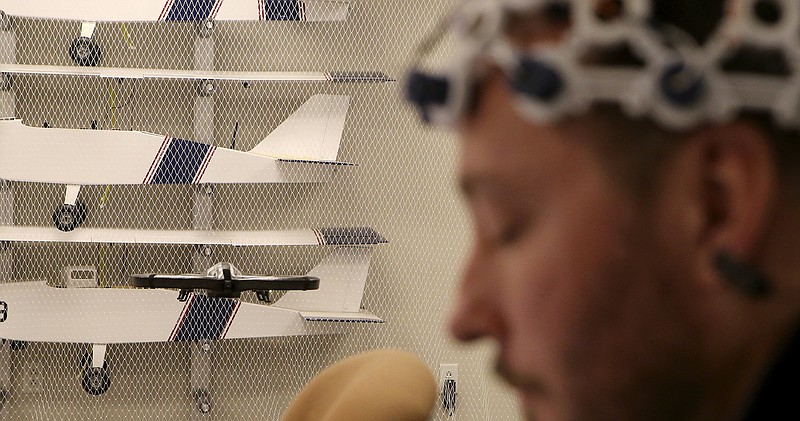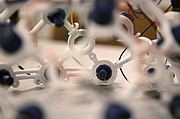Controlling machines with brainwaves seems like science fiction, but if a University of Tennessee at Chattanooga research project succeeds, it could be the wave of the future.
Daniel Pack, dean of the College of Engineering and Computer Science at UTC, received about $300,000 grant from the U.S. Army to study technology that could allow soldiers to command drones, also called unmanned aerial vehicles, or UAVs, with their thoughts instead of burdensome equipment.
"The goal of the project is to allow humans - it doesn't have to be just in the military setting - to interact with machines in a variety of ways using our brainwaves," Pack said. "I think there's a lot of interest that's coming on for the project."
Using his mind as the control station, electrical engineering major Tony Ferguson, who began working on the project in January, managed to launch and land a drone for the first time in September.
Ferguson wears a headset of 16 sensors, which measure electrical impulses from his brain. The signals are then sent to a computer that converts the measurements into commands the drone recognizes.
"When you or I are thinking of an action, or doing a physical movement, such as waving your hand, blinking your eyes, moving your legs, it triggers a certain type of brainwave," Pack said.
When Ferguson closes his eyes to simulate darkness, the visual cortex of his brain generates a wave of about 10.5 hertz. The drone is programmed to recognize a 10.5 hertz reading from that cortex channel as the command for takeoff.
"The things we learn in class, they're all theoretical, and it's math, math, and math. And to be given a project where you get to apply it directly to a real system is a good learning experience," Ferguson said. "When it finally did work it was just awesome."
Zach Ruble, a post-doctoral researcher in UTC's electrical engineering department and adviser on the drone project, said the hope is eventually to direct a "swarm" of robots using commands from the headset.
"The end goal would be to control a number of different drones to do some abstract task, like search and rescue, and that signal would be sent out to a group of robots that could autonomously decide what they need to do," Ruble said.
The project is still in the early phases of development and will require more research to determine if the technology is even feasible.
Ruble said one of the biggest challenges is identifying brainwave patterns that are similar across all individuals, so that the headset can be transferred to people other than Ferguson.
Medical researchers have successfully used brain implants in paralysis patients to transmit intention to move into electrical stimulation, but Pack said an obstacle in the drone project is detecting brain waves through noninvasive means.
"It's a much harder problem to solve, just because we don't have that direct brain wave that might drive your motor skills, but we're picking it up on the periphery, outside your skull," he said.
Another challenge will be converting the headset with its pointy sensors into a form that's useful for soldiers.
"When they wear their helmets, they get sweaty inside and the helmet moves around," Pack said. "It becomes harder to get those needed brainwaves detected."
But as technology evolves and the military importance of drones grows, Pack said, so will the need to solve these research problems.
Contact staff writer Elizabeth Fite at efite@timesfreepress.com or 423-757-6673.

